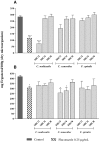Antifungal activity of phlorotannins against dermatophytes and yeasts: approaches to the mechanism of action and influence on Candida albicans virulence factor
- PMID: 23951297
- PMCID: PMC3741211
- DOI: 10.1371/journal.pone.0072203
Antifungal activity of phlorotannins against dermatophytes and yeasts: approaches to the mechanism of action and influence on Candida albicans virulence factor
Abstract
In the last few decades, fungal infections, particularly nosocomial, increased all around the world. This increment stimulated the search for new antifungal agents, especially those derived from nature. Among natural products, those from marine sources have gained prominence in the last years. Purified phlorotannins extracts from three brown seaweeds (Cystoseira nodicaulis (Withering) M. Roberts, Cystoseira usneoides (Linnaeus) M. Roberts and Fucus spiralis Linnaeus) were screened for their antifungal activity against human pathogenic yeast and filamentous fungi. The purified phlorotannins extracts from the studied seaweeds displayed fungistatic and fungicidal activity against yeast and dermatophytes, respectively, pointing to their interest as anti-dermatophyte agent. C. albicans ATCC 10231 was the most susceptible among yeast, while Epidermophyton floccosum and Trichophyton rubrum were the most susceptible among dermatophytes. Since the antifungal mechanism constitutes an important strategy for limiting the emergence of resistance to the commercially available agents, the mechanism of action of purified phlorotannins extracts was approached. C. nodicaulis and C. usneoides seem to act by affecting the ergosterol composition of the cell membrane of yeast and dermatophyte, respectively. F. spiralis influenced the dermatophyte cell wall composition by reducing the levels of chitin. Phlorotannins also seem to affect the respiratory chain function, as all of the studied species significantly increased the activity of mitochondrial dehydrogenases and increased the incorporation of rhodamine 123 by yeast cells. Phlorotannins from F. spiralis inhibited the dimorphic transition of Candida albicans, leading to the formation of pseudohyphae with diminished capacity to adhere to epithelial cells. This finding is associated with a decrease of C. albicans virulence and capacity to invade host cells and can be potentially interesting for combined antifungal therapy, namely for the control of invasive candidiasis.
Conflict of interest statement
Figures




References
-
- Richardson MD, Warnock DW (2012) In: Fungal infection: diagnosis and management. 4rd ed, Wiley-Blackwell, Oxford, UK.
-
- Thomas NV, Kim SK (2011) Potential pharmacological applications of polyphenolic derivatives from marine brown algae. Environ Toxicol Phar 32: 325–335. - PubMed
-
- Martins VP, Dinamarco TM, Curti C, Uyemura SA (2011) Classical and alternative components of the mitochondrial respiratory chain in pathogenic fungi as potential therapeutic targets. J Bioenerg Biomembr 43: 81–88. - PubMed
Publication types
MeSH terms
Substances
LinkOut - more resources
Full Text Sources
Other Literature Sources

